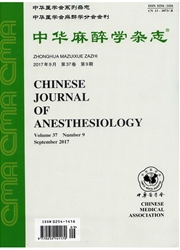

 中文摘要:
中文摘要:
目的评价不同浓度PNU282987对大鼠心肌细胞缺氧/复氧损伤的影响。方法新生大鼠,分离纯化心肌细胞,培养72h时,以5×105个/ml的密度接种于6孔板中(2ml/TL),108个培养孔,采用随机数字表法,分为6组(n=18):正常对照组(c组)、缺氧,复氧组(AIR组)、3、10、30、60μmol/LPNU282987组(P3组、P10组、P30组和P60组)。采用缺氧6h复氧6h的方法制备心肌细胞缺氧/复氧损伤模型,P3组、P10组、P30组和P60组复氧时分别加入相应浓度的PNU282987。采用比色法检测心肌细胞乳酸脱氢酶(LDH)漏出水平,采用膜联蛋白V,碘化丙啶双染流式细胞术检测心肌细胞凋亡情况,采用ELISA法检测培养上清液白细胞介素-6(IL-6)和肿瘤坏死因子-α(TNF—α)的浓度。结果与c组比较,AIR组、P3组、P10组、P30组和P60组心肌细胞LDH漏出率、早期细胞凋亡率和晚期细胞凋亡率升高,培养上清液IL-6和TNF-α的浓度升高(P〈0.01);与AIR组比较,P3组、P10组、P30组和P60组心肌细胞LDH漏出率和早期细胞凋亡率降低,P30组最明显,培养上清液IL-6和TNF-α的浓度降低,且呈浓度依赖性(P〈O.05或O.01),P3组、P10组、P30组和P60组晚期细胞凋亡率差异无统计学意义(P〉0.05)。结论3、10、30、60μmol/LPNU282987可减轻大鼠心肌细胞缺氧/复氧损伤,而30μmol/L时效果最明显。
 英文摘要:
英文摘要:
Objective To evaluate the effects of different concentrations of PNU282987 on anoxia/ reoxygenation (A/R) injury to cardiomyocytes of rats. Methods After being cultured for 72 h, cardiomyoeytes obtained from neonatal rats were seeded in 6-well plates (2 ml/well, a total of 108 wells) at a density of 5× 105 cells/ml and randomly divided into 6 groups according to a random number table (n = 18 each) : control group (C group) ; A/R group; 3, 10, 30 and 60 Receptors,cholinergic; Myocytes,cardiac; Cell hypoxla; Oxygen mol/L PNU282987 groups (P3, P10, P30 and P60 groups). The cells were exposed to anoxia for 6 h followed by reoxygenation with 95% 02- 5% CO2at 37 ℃ for 6 h. The corresponding concentrations of PNU282987 were added to the culture medium during reoxygenation in P3, P10, P30 and P6o groups. The amount of lactic dehydrogenase (LDH) released was measured using colorimetric method. Apoptosis in cardiomyoeytes was detected by flow cytometry with Annexin V/propidium iodide staining. The concentrations of interleukin-6 (IL-6) and tumor necrosis factor-alpha (TNF-α) in the supernatant were determined using enzyme-linked immunosorbent assay. Results Compared to C group, the LDH release rate, early and late apoptosis rates, and the concentrations of IL-6 and TNF-α in the supernatant were significantly increased in A/R, P3, P10, P30 and P60 groups. Compared to A/R group, the LDH release rate and early apoptosis rate were significantly decreased (especially in group P30 ), and the concentrations of IL-6 and TNF-α in the supernatant were decreased in a concentration-dependent manner in P3, P10, P30 and Pso groups. Compared to A/R group, no significant changes were found in late apoptosis rate in P3, P10, P30 and P60 groups. Conclusion PNU282987 3, 10, 30 and 60 μmol/L can reduce A/R injury to cardiomyocytes of rats, especially 30 μmol/L.
 同期刊论文项目
同期刊论文项目
 同项目期刊论文
同项目期刊论文
 Postconditioning with vagal stimulation attenuates local and systemic inflammatory responses to myoc
Postconditioning with vagal stimulation attenuates local and systemic inflammatory responses to myoc Postconditioning with α7nAChR agonist attenuates systemic inflammatory response to myocardial ischem
Postconditioning with α7nAChR agonist attenuates systemic inflammatory response to myocardial ischem Combined postconditioningwith ischemia and α7nAChR agonist produces an enhanced protection against r
Combined postconditioningwith ischemia and α7nAChR agonist produces an enhanced protection against r Combined Vagal Stimulation and Limb Remote Ischemic Perconditioning Enhances Cardioprotection via an
Combined Vagal Stimulation and Limb Remote Ischemic Perconditioning Enhances Cardioprotection via an 期刊信息
期刊信息
